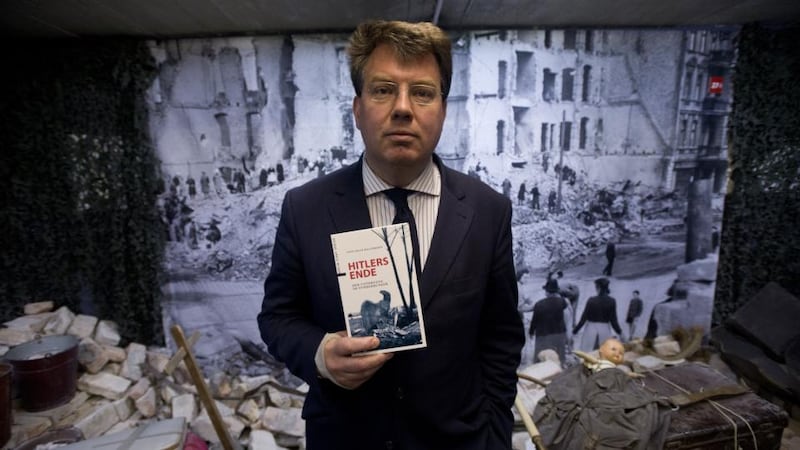Adolf Hitler liked to think big. But on this morning 70 years go, his "thousand year" Reich was very small indeed.
Six years earlier the German dictator had marched his troops into Poland, triggering the second World War in a devastating push to dominate Europe and win Lebensraum across the European continent for his Aryan master race.
Hitler's megalomania cost more than 50 million lives. On April 30th, 1945, the territory of the Third Reich had effectively shrunk to just 50 hectares around the shattered Reich Chancellery, south of the Brandenburg Gate. Red Army soldiers had the ruined German capital surrounded. The game was up.


The previous day, 8m below ground in his bunker, Hitler married his longtime girlfriend, Eva Braun. Then, on the afternoon of April 30th, history's most notorious newlyweds locked themselves in their underground living room.
Some time between 3.15pm and 3.50pm they sat on their couch and shot themselves. Aides then removed the bodies and burned them in the garden above.
Tourism attraction
On a sunny afternoon seven decades later, groups of tourists arrive and depart at this very site every few minutes and stare in quiet fascination at what little there is to see.
Tucked between the Holocaust memorial, a new shopping centre and a 1980s East German housing development, one of the most infamous sites in world history is, today, a scrappy car park.
Rosemary Rowley, from Sutton in Dublin, is visiting Berlin with her daughters Louise, Michelle and Nicola. They have three days in the city and are seeing the Third Reich sights today and a concentration camp near Berlin tomorrow.
“This wasn’t hundreds of years ago, just 70, that’s nothing,” said Mrs Rowley.
How long, do they think, will the Nazi era continue to fascinate?
“We keep learning new things,” says Louise. “There’s so much information and footage we didn’t see before. Being in Berlin now and looking around, though, it’s hard to believe anything like that ever happened here.”
Quietly watching the comings and goings is Sven Felix Kellerhoff, a journalist with Germany's Die Welt newspaper. Kellerhoff specialises in historical themes and has written one of the few reliable books about the Führerbunker and its long afterlife.
After victorious allies visited Berlin, the chancellery was demolished and the underground bunker covered over. For three decades much of the site was in the cold war no man’s land between East and West Berlin.
Several failed attempts to blow up the structure failed, all hampered by 4.5m reinforced concrete walls. Eventually, in the 1980s, the roof was removed and the structure filled up with rubble.
Information plaque
It was only in 2006 that Kellerhoff won a long bureaucratic battle with the city to erect an information plaque on the site explaining what still lies buried in sandy soil.
The writer feels vindicated that his sign remains a popular attraction. It has never been damaged, nor has it – as city officials feared – made the Führerbunker site a place of pilgrimage for neo-Nazis.
“Why would they come here, the place where Hitler failed?” said Kellerhoff. “The tourists are attracted by the creepiness factor, which is understandable emotionally, but I still say it’s better that they come than not at all.”
Seventy years after the second World War ended, how to deal with their Hitler legacy remains a dilemma for Berlin city fathers. On the one hand, the Nazis are untouchable; on the other hand, tourism is Berlin’s biggest industry, and Hitler its unique selling point.
City tourism chief Bernhard Kieker denies Berlin is chasing the "dark tourism" fascination with disaster and tragedy sites. "We don't use that term at all," he says. Yet the last years have seen a clear shift in how Berlin remembers its past. For decades the city allowed private operators to satisfy the insatiable Nazi appetites of visitors, with little quality control.
However, the city has muscled in for this year’s anniversary, copying its successful Berlin Wall campaign from last year with a sizeable programme of exhibitions, tours and other events to contextualise the May 1945 capitulation.
Interest in Nazis
Seven decades after he killed himself, Adolf Hitler is a nice little earner for the chronically broke German capital. Just don’t expect the city to admit it.
“I thought the peak of interest in the Nazis was reached around 1995, but it just continues to grow,” said Kellerhoff as the next walking tour arrives at Hitler’s bunker.
“We shouldn’t reduce German history to the Third Reich, yet it was probably the most important 12 years and will stay that way.”











